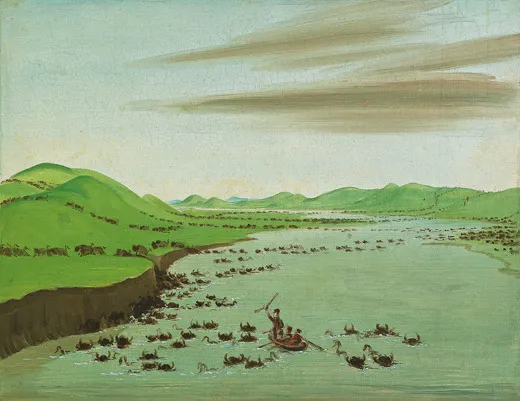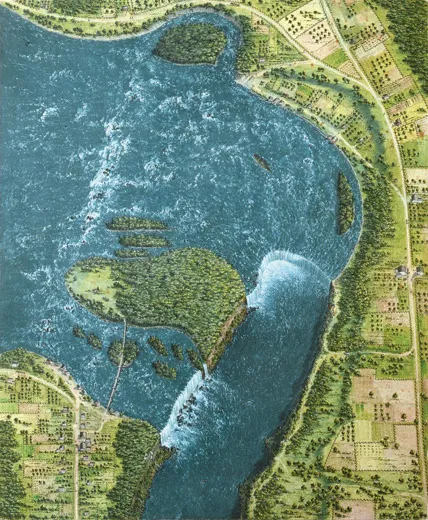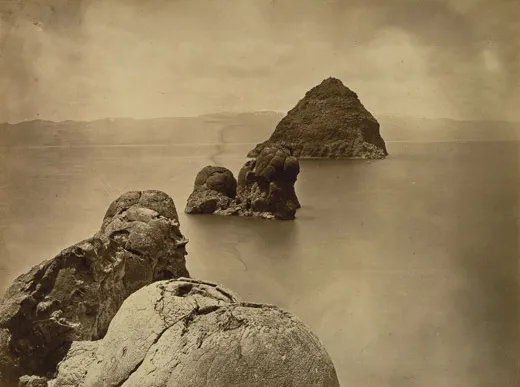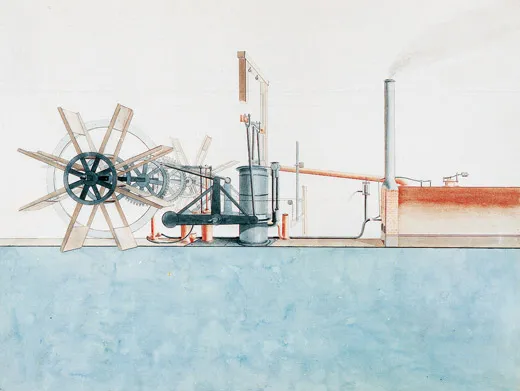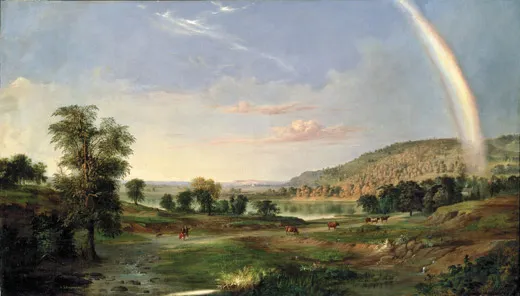America’s 19th Century Highway: The River
A new exhibition of American wonders underscores the debt our country owes to its waterways
/https://tf-cmsv2-smithsonianmag-media.s3.amazonaws.com/filer/Water-Flow-Goerge-Catlin-Niagara-Falls-631.jpg)
At the start of the 19th century, the United States was still a place where many people ate what they grew and many women made the family clothes. But with technological innovations such as the railroad, telegraph and steamboat, the United States grew into one of the world’s leading industrial powers. Meanwhile, the country had become a transcontinental empire, which these innovations in transportation and communications helped facilitate.
The Great American Hall of Wonders, an exhibition at the Smithsonian American Art Museum in Washington, D.C., presents a graphic representation of this transformative era. It emphasizes precisely those forces of science and technology that were driving the changes: images of water, like those on the following pages, typify the interrelationships among art, technology and science forged by the Americans of that era. The exhibition’s organizer, Claire Perry, an independent curator, writes that she was interested in “the nineteenth century’s spirit of inquiry through science and technology, the arts, and materials of everyday life that defined the experimentations taking place in the vast laboratory of the United States.”
Waters were the interstate highways of the early 19th-century United States. Many Americans earned their living as farmers, and waterways provided an efficient means of getting crops to market. The steamboat greatly enhanced that ability. In 1787, John Fitch and James Rumsey each built American steamboats, but they could not sustain financial backing and died in frustration. The first commercially successful steamboat, Robert Fulton’s Clermont, plied the Hudson River starting in 1807. (The exhibition includes two drawings, below right, for Fulton’s steamboat-engine patent application.) Steamboats proved most valuable for trips upstream on rivers with powerful currents, of which the Mississippi was the ultimate example. Previously, traffic on the Mississippi had been mostly downstream; at New Orleans boatmen broke up their barges to sell for lumber and walked back home to Kentucky or Tennessee along the Natchez Trace.
Sandbars and other obstructions impeded commerce. Abraham Lincoln was among the political leaders of the time who favored government aid for making rivers navigable. Lincoln even patented an invention to help grounded steamboats lift themselves off shoals.
It was also an era of monumental canal-building, usually to connect two natural waterways or parallel a single stream and avoid waterfalls, rapids or other impasses. The country’s most economically important and financially successful artificial waterway was the Erie Canal in New York. Astonishingly, this ambitious undertaking from Albany to Buffalo—363 miles—was completed in eight years. The canal contributed mightily to the prosperity of New York City and brought commercial civilization to the western part of the state, including Niagara Falls.
George Catlin’s eye-popping, circa 1827 painting A Bird’s Eye View of Niagara Falls synthesizes landscape art with cartography. The bird’s-eye view that we take for granted today likely struck viewers at the time as highly imaginative. Niagara Falls, which Perry describes as “an icon of the beauty, monumentality and power of the U.S. landscape,” typified for many Americans the tremendous power of Nature and God. Meanwhile, businessmen harnessed Niagara’s power for industry.
Catlin, anxious to record an America in the process of disappearing, created Buffalo Herds Crossing the Upper Missouri in 1832. The painting contrasts the vast number of bison swimming across the river with the handful of explorers in a rowboat. A man in the boat seems to wave his rifle defiantly at the animals, a gesture that to a modern viewer would appear to predict their coming slaughter.
For 19th-century Americans, water represented both nature and civilization. The painter Robert S. Duncanson, then the nation’s most celebrated African-American artist, subtly addresses both these themes in Landscape with Rainbow of 1859. The rainbow, of course, has been the object of scientific, artistic and religious interest for centuries. And this painting has been described over the decades as an Arcadian celebration. The artist captures the transition from wilderness to settlement. The calm water and verdant land are balanced by the children, the cabin and the cattle grazing. The rainbow—one of nature’s most evanescent phenomena—reminds us today that it was also a fragile moment. The work is a rich and, to our eyes, poignant commentary on Americans’ early enthusiasm for progress.
Daniel Walker Howe is a historian and the author of What Hath God Wrought: The Transformation of America, 1815-1848.
